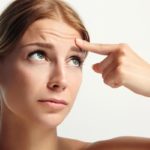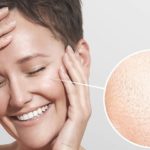Some common factors that contribute to oily acne-prone skin
– Enlarged pores lead to excess sebum production. At this point, dust and bacteria can easily adhere and cause breakouts.
– Hormonal imbalance: Fluctuations in hormones, such as estrogen and androgen, can stimulate the sebaceous glands to produce more oil, resulting in different types of acne like blackheads on the nose, cystic acne on the chin, and pustules on the nose.

– Improper skincare: Inadequate cleansing and abuse of cosmetics can weaken the skin, compromise its protective barrier, and make it more sensitive, leading to the formation of acne.
– Prolonged stress: Prolonged stress and anxiety can stimulate the sebaceous glands to produce more sebum, resulting in oily skin and increased likelihood of acne.
Daytime skincare for oily acne-prone skin
Cleansing
Cleansing is the first step in your skincare routine for oily acne-prone skin. The most important thing is to choose the right cleanser that suits your skin type. Pay attention to proper massaging techniques, working from top to bottom and from bottom to top.
Exfoliation
For mild acne, exfoliation can be done 1-2 times per week. However, for severe acne with redness and inflammation, this step should be avoided as it can cause further irritation and infection.
Use of toner
Choose natural products that are alcohol-free, oil-free, fragrance-free, and have oil-control and pore-tightening properties. Use a cotton pad to apply the toner gently onto your face. In your acne skincare routine, you can combine toner with a lotion mask.
Spot treatment
Serums for acne treatment usually contain ingredients such as vitamin B5, vitamin E, glycerin, and AHA, which help stimulate cell regeneration, replenish moisture, and quickly dry out acne.
Moisturizing
When choosing a moisturizer for acne-prone skin, pay attention to the ingredients and texture of the product. Moisturizers with natural ingredients such as tea tree, green tea, cherry blossom, chamomile, and purslane help prevent inflammation.

Sunscreen
Applying sunscreen is an essential step in your skincare routine for acne-prone skin. Sunscreen protects the skin from the harmful effects of UV rays, has antibacterial properties, and effectively prevents acne.
Nighttime skincare for oily acne-prone skin
Makeup removal
Whether you wear makeup or not, it is essential to prioritize makeup removal. This step helps remove makeup, dirt, and excess oil from the skin. Simply use a cotton pad soaked in makeup remover to gently cleanse your face.
Cleansing
After removing makeup, wash your face with a facial cleanser to deeply cleanse the skin, allowing it to better absorb nutrients in the subsequent skincare steps. In this step, follow the same facial cleansing techniques as in the daytime routine.
Use of toner
Toner helps balance the pH level of the skin, restores moisture balance, and removes any remaining impurities or excess oil.
Face mask
– Clay masks help minimize pores, deeply cleanse the skin, regulate oil production, and reduce inflammatory acne.
– Bubble masks help deep cleanse pores, reduce inflammatory acne, and control excess sebum effectively.
Note that all types of masks should only be applied for 15 minutes.
Moisturizing
Using a night moisturizer is an essential step in skincare for nourishing the skin. Moisturizers not only provide hydration but also help reduce sebum production and minimize the risk of acne.
Use of spot treatment
Apply spot treatment only to the areas with acne. It is recommended to seek advice from a dermatologist regarding the concentration of acne treatment ingredients. Choosing a random product can cause unintended skin damage.
“How to Treat Oily, Acne-Prone Skin: 5 Vital Steps”
Are you struggling with oily skin and acne-related issues in Vietnam? Find out how to get the clear and glowing skin you deserve with our top 5 tips for tackling oily skin!
“How to treat large pores and achieve a smooth, flawless skin”
Enlarged pores can be a significant concern as they affect the overall appearance of the skin, making it uneven, dull, and less radiant. Their visibility can detract from the aesthetic appeal of the skin. It is crucial to find effective solutions to minimize the appearance of enlarged pores and improve the overall complexion.



































